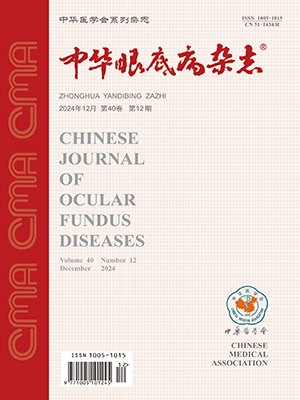| 1. |
Ando E, Ando Y, Okamura R, et al. Ocular manifestations of familial amyloidotic polyneuropathy typeⅠ:long-term follow up[J]. Br J Ophthalmol, 1997, 81(4):295-298.
|
| 2. |
Suhr OB, Lindqvist P, Olofsson BO, et al. Myocardial hypertrophy and function are related to age at onset in familial amyloidotic polyneuropathy[J]. Amyloid, 2006, 13(3):154-159.
|
| 3. |
谢兵, 蔡善君, 蒋模, 等.家族性玻璃体淀粉样变性甲状腺激素结合蛋白Gly83Arg突变家系[J].中华眼底病杂志, 2013, 29(1):89-91.
|
| 4. |
González-Duarte A, Lem-Carrillo M, Cárdenas-Soto K. Description of transthyretin S50A, S52P and G47A mutations in familial amyloidosis polyneuropathy[J]. Amyloid, 2013, 20(4):221-225.
|
| 5. |
Falk RH, Comenzo RL, Skinner M. The systemic amyloidoses[J]. N Engl J Med, 1997, 337(13):898-909.
|
| 6. |
Bulawa CE, Connelly S, Devit M, et al. Tafamidis, a potent and selective transthyretin kinetic stabilizer that inhibits the amyloid cascade[J]. Proc Natl Acad Sci USA, 2012, 109(24):9629-9634.
|
| 7. |
Ferreira N, Santos SA, Domingues MR, et al. Dietary curcumin counteracts extracellular transthyretin deposition:insights on the mechanism of amyloid inhibition[J]. Biochim Biophys Acta, 2013, 1832(1):39-45.
|
| 8. |
Hayashi Y, Mori Y, Yamashita S, et al. Potential use of lactosylated dendrimer (G3)/α-cyclodextrin conjugates as hepatocyte-specific siRNA carriers for the treatment of familial amyloidotic polyneuropathy[J]. Mol Pharm, 2012, 9(6):1645-1653.
|
| 9. |
Su Y, Jono H, Torikai M, et al. Antibody therapy for familial amyloidotic polyneuropathy[J]. Amyloid, 2012, 19(Suppl 1):S45-46.
|
| 10. |
陈凌燕, 吕林, 张平, 等.玻璃体淀粉样变性伴转甲蛋白Arg-83突变一例[J].眼科学报, 2008, 24(1):65-67.
|
| 11. |
石一宁, 惠延年.玻璃体淀粉样变性一家系[J].中国实用眼科杂志, 1998(2):48.
|
| 12. |
Russo M, Mazzeo A, Stancanelli C, et al. Transthyretin-related familial amyloidotic polyneuropathy:description of a cohort of patients with Leu64 mutation and late onset[J]. J Peripher Nerv Syst, 2012, 17(4):385-390.
|
| 13. |
Jacobsson B, Collins VP, Grimelius L, et al. Transthyretin immunoreactivity in human and porcine liver, choroid plexus, and pancreatic islets[J]. J Histochem Cytochem, 1989, 37(1):31-37.
|
| 14. |
Schreiber G, Aldred AR, Jaworowski A, et al. Thyroxine transport from blood to brain via transthyretin synthesis in choroid plexus[J]. Am J Physiol, 1990, 258(2 Pt 2):338-345.
|
| 15. |
Saraiva MJ, Costa PP, Goodman DS. Studies on plasma transthyretin (prealbumin) in familial amyloidotic polyneuropathy, Portuguese type[J]. J Lab Clin Med, 1983, 102(4):590-603.
|
| 16. |
Benson MD, Dwulet FE. Prealbumin and retinol binding protein serum concentrations in the Indiana type hereditary amyloidosis[J]. Arthritis Rheum, 1983, 26(12):1493-1498.
|
| 17. |
Buxbaum J, Anan I, Suhr O. Serum transthyretin levels in Swedish TTR V30M carriers[J]. Amyloid, 2010, 17(2):83-85.
|




